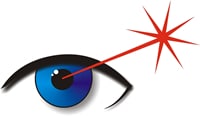Frequently Asked Questions
FAQ
The best candidates are between 18 and 60 years old and are tired of glasses or contacts for distance vision. Your eyes must be otherwise healthy and you should be in good general health. Laser Vision Correction can benefit patients with most degrees of nearsightedness and astigmatism and some degrees of farsightedness. For moderate to high degrees of farsightedness, laser vision correction may not be the best procedure for you. However, a procedure called Refractive Lens Exchange has been giving these folks excellent results in our hands for years. Dr. Pajka offers free screenings for you to find out which is procedure is right for you. The benefits to a life with Clear Vision are priceless!
LASIK changes the way light is bent, or refracted, as it passes through the cornea so that it focuses properly on the retina and objects can be seen clearly. A device called a microkeratome cuts a thin flap in the surface of the cornea. An excimer laser beam then reshapes the cornea’s curvature to improve vision. The flap is then closed and covered with a protective contact lens. The entire procedure takes only 15-30 minutes per eye, and patients are often ready to leave within an hour or two. The flap heals on its own within a few days with no need for stitches.
Most people take only a day or two off work – if you have your treatment done on a Thursday, most people are back to work on Monday, although many people can return the next day. Your vision will be hazy at first and then it will begin to clear after a day or so. Each person does respond differently partly depending on his or her age and prescription. Once you have recovered, start enjoying activities with your new vision!
Refractive Lens Exchange (RLE) is the procedure of choice in patients over 45 years old who are farsighted and depend on their glasses or contact lenses to see both near and distance clearly. These patients see a vast improvement in their ability to see far away and near without their glasses, although some may still prefer reading glasses for up close to “fine tune” things. This procedure replaces the natural lens of the eye with the better focusing individualized lens implant. This allows for clearer vision without glasses or contact lenses. Refractive Lens Exchange is very similar to the procedure done in Cataract Surgery. Another advantage of Refractive Lens Exchange is that since the natural lens is replaced, patients won’t have to suffer through the vision changing hassles of developing cataracts later on in life. With the option of the exciting multifocal and presbyopia correcting implants, patients have a potential to eliminate their glasses for near and for distance.
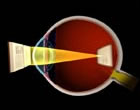 If you are nearsighted, you cannot see things clearly in the distance. This condition occurs when the cornea, which is located on the front part of the eye, is too long or steeply curved. Because of this curvature, light entering the eye focuses in front of the retina (film of the camera) instead of on it. This causes blurry vision.
If you are nearsighted, you cannot see things clearly in the distance. This condition occurs when the cornea, which is located on the front part of the eye, is too long or steeply curved. Because of this curvature, light entering the eye focuses in front of the retina (film of the camera) instead of on it. This causes blurry vision.
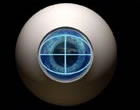 Astigmatism occurs when the eyeball is oblong (football shaped). Light will focus in two or more focal points causing blurry vision for both distance and near vision. Astigmatism can be corrected along with nearsightedness and farsightedness.
Astigmatism occurs when the eyeball is oblong (football shaped). Light will focus in two or more focal points causing blurry vision for both distance and near vision. Astigmatism can be corrected along with nearsightedness and farsightedness.
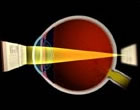 People who are farsighted cannot see far away or up close without glasses or contacts. Lower amounts of farsightedness can be treated with LASIK to improve distance vision. Higher amounts can be treated by Refractive Lens Exchange. Farsightedness is different from a condition call presbyopia, which is the natural loss of focusing ability for near objects as we age. Currently there are no great treatments for presbyopia other than bifocals or reading glasses. However, often times farsighted patients undergoing Laser Vision Correction or Refractive Lens Exchange will see better up close without glasses than they did before without glasses. In general, most of the procedures that we do for nearsightedness, farsightedness, and astigmatism are to improve a person’s distance vision. If you are over 40-45 years of age, reading glasses may still be helpful to “fine tune” up close vision.
People who are farsighted cannot see far away or up close without glasses or contacts. Lower amounts of farsightedness can be treated with LASIK to improve distance vision. Higher amounts can be treated by Refractive Lens Exchange. Farsightedness is different from a condition call presbyopia, which is the natural loss of focusing ability for near objects as we age. Currently there are no great treatments for presbyopia other than bifocals or reading glasses. However, often times farsighted patients undergoing Laser Vision Correction or Refractive Lens Exchange will see better up close without glasses than they did before without glasses. In general, most of the procedures that we do for nearsightedness, farsightedness, and astigmatism are to improve a person’s distance vision. If you are over 40-45 years of age, reading glasses may still be helpful to “fine tune” up close vision.
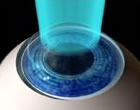 With LASIK, a thin sheet of cells on the front surface of the eye is lifted and then the treatment is done underneath. These cells are then replaced and quickly heal without sutures. With PRK, the same laser treatment is done, but the cells are cleaned off and then have to reheal. So with PRK the recovery takes longer. The FDA approved the lasers originally expecting doctors would be doing PRK, but laser vision correction has advanced quickly and most refractive surgeons perform more LASIK than PRK procedures. Because of the faster recovery and increased comfort, most patients are choosing to have LASIK. However, the long term visual results of LASIK and PRK are equivalent. In other words, LASIK is not a better procedure than PRK, it is just convenient See Alternatives in Refractive Surgery. PRK uses an Excimer laser to reshape the front of the cornea to reduce or eliminate nearsightedness, farsightedness or astigmatism. In PRK, the front surface is prepared by cleaning the front surface free of cells before applying the laser treatment. A bandage contact is worn afterwards for the first few days to allow healing of the surface. Vision requires some time to heal and recover after PRK.
With LASIK, a thin sheet of cells on the front surface of the eye is lifted and then the treatment is done underneath. These cells are then replaced and quickly heal without sutures. With PRK, the same laser treatment is done, but the cells are cleaned off and then have to reheal. So with PRK the recovery takes longer. The FDA approved the lasers originally expecting doctors would be doing PRK, but laser vision correction has advanced quickly and most refractive surgeons perform more LASIK than PRK procedures. Because of the faster recovery and increased comfort, most patients are choosing to have LASIK. However, the long term visual results of LASIK and PRK are equivalent. In other words, LASIK is not a better procedure than PRK, it is just convenient See Alternatives in Refractive Surgery. PRK uses an Excimer laser to reshape the front of the cornea to reduce or eliminate nearsightedness, farsightedness or astigmatism. In PRK, the front surface is prepared by cleaning the front surface free of cells before applying the laser treatment. A bandage contact is worn afterwards for the first few days to allow healing of the surface. Vision requires some time to heal and recover after PRK.
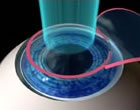 LASIK is a modification of laser vision correction. In LASIK, a thin flap of cornea is lifted in a single sheet to permit laser treatment of the eye’s exposed inner surface. Following the procedure, the corneal flap is repositioned. The corneal tissue has extraordinary natural bonding qualities that allow effective healing without the use of stitches. Many patients report immediate vision improvement with minimal recovery time.
LASIK is a modification of laser vision correction. In LASIK, a thin flap of cornea is lifted in a single sheet to permit laser treatment of the eye’s exposed inner surface. Following the procedure, the corneal flap is repositioned. The corneal tissue has extraordinary natural bonding qualities that allow effective healing without the use of stitches. Many patients report immediate vision improvement with minimal recovery time.
Glaucoma is one of the leading causes of blindness in the United States. It occurs when the pressure inside the eye rises high enough to damage the optic nerve. Symptoms include blurred vision, loss of peripheral vision, halo effects around lights and painful or reddened eyes. Testing by an ophthalmologist or optometrist can detect glaucoma before symptoms appear and begin treatment to prevent vision loss. People at greatest risk for developing glaucoma include those who are over 40, diabetic, near-sighted, African-American, or who have a family history of glaucoma.
Macular degeneration occurs when the center of the retina degrades, causing a progressive loss of vision. Symptoms include:
- A gradual loss of ability to see objects clearly
- A gradual loss of color vision
- Distorted vision
- A dark or empty area appearing in the center of vision
There are two kinds of macular degeneration: “wet” and “dry.” The “wet” form can be treated in its early stages. Regular eye exams are highly recommended to detect macular degeneration early and prevent permanent vision loss.
Vision loss from cataracts can often be improved with prescription glasses and contact lenses. For people who are significantly affected by cataracts, replacement surgery may be the preferred method of treatment. Cataract replacement is the most common surgical procedure in the country. During this procedure, the cloudy lens is removed and replaced with an artificial one called an intraocular lens or IOL.
Diabetic retinopathy is a complication of diabetes that weakens the blood vessels that nourish the retina. Vision can be lost if these weak vessels leak, swell or develop thin branches. In its advanced stages, diabetic retinopathy can cause blurred or cloudy vision, floaters and blind spots – and, eventually, blindness. This damage is irreversible. However, treatment can slow disease progression and prevent further vision loss. Treatment modalities include laser and surgical procedures.
Yes. People with diabetes are most susceptible to developing it, but your risk is reduced if you follow your prescribed diet and medications, exercise regularly, control your blood pressure, and avoid alcohol and cigarettes. Regular eye exams are an integral part of making sure your eyes remain healthy.
“Dry eye” often occurs during the natural aging process. It can also form as a result of eyelid or blinking problems, certain medications such as antihistamines and oral contraceptives, climate (low humidity, wind, dust), injury, and various health problems such as arthritis.
Symptoms include:
- Irritated, scratchy, dry, uncomfortable or red eyes
- A burning sensation or feeling of something foreign in your eyes
- Blurred vision
In addition to being uncomfortable, dry eye can damage eye tissue, scar the cornea and impair vision. Dry eye is not preventable, but it can be controlled before harm is done to your eyes. Treatment can take many forms. Non-surgical methods include blinking exercises, increasing humidity at home or work, and use of artificial tears or moisturizing ointment. If these methods fail, small punctal plugs may be inserted in the corners of the eyes to limit tear drainage, or the drainage tubes in the eyes may be surgically closed.
